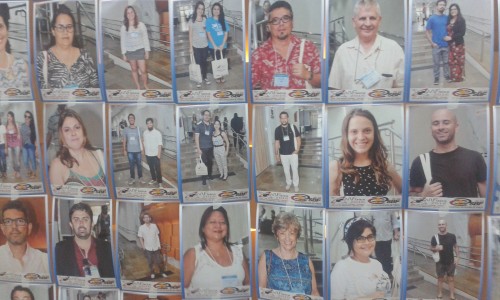Tag archives: antimatter
Antimatter comes to Brazil
By Matin Durrani in Natal, Brazil
There can’t be many physics experiments to have been visited by members of not one, but two different rock bands. But then there’s something fundamentally captivating about the work of the ALPHA collaboration at the CERN particle-physics lab near Geneva, which is studying the properties of antimatter.
As Jeffrey Hangst from Aarhus University in Denmark revealed in his plenary talk at the 50th anniversary meeting of the Brazilian Physics Society (SBF) yesterday, the ALPHA collaboration has not only played host to a visit from legendary 1970s rockers David Crosby and Graham Nash, but in July also welcomed members of British alternative “space rock” outfit Muse while they were on a visit to CERN.
View all posts by this author | View this author's profile
Neutrinos that go bump in the night
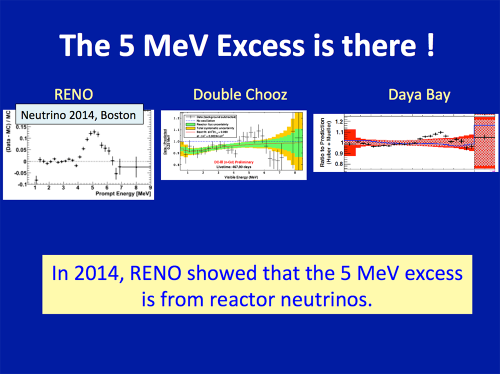
Triple bump: the 5 MeV bump data presented by K Joo at the Neutrino 2016 conference. (Courtesy: RENO Collaboration)
By Tushna Commissariat
A final mystery that was mentioned at the Neutrino 2016 I attended in London this week was yet another unexpected “bump” in data at 5 MeV, measured while monitoring the neutrino flux from nuclear power plants. Starting with the RENO experiment in 2012, it was spotted by the Double Chooz experiment in 2014 and finally by the Daya Bay neutrino experiment earlier this year. While the initial signal was not of high enough statistical significance, it has now held up over time and more measurements.
Limiting factors for the elusive sterile neutrino
By Tushna Commissariat
More data are definitely needed in the quest for the sought-after sterile neutrino. That much was clear as more than 10 different global neutrino detectors announced at the Neutrino 2016 conference in London that they have found no evidence for the slippery particle’s existence. The sterile neutrino is a hypothetical and much-debated fourth type of neutrino that would contribute mass, but only interact with the other three “active neutrinos”, making it that much more difficult to detect. In the video above, Physics World features editor Louise Mayor explains why researchers are so keen to nail down this particle, should it exist, as it may single-handedly explain some of the biggest mysteries in physics today, including dark matter.
View all posts by this author | View this author's profile
Symmetry-violating neutrinos may hold the key to antimatter
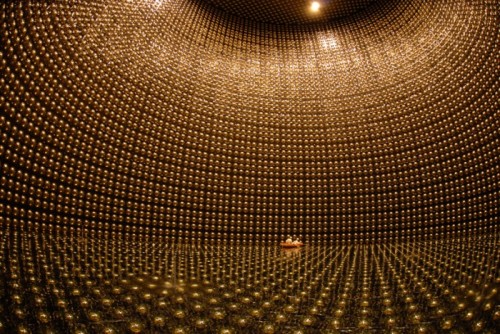
Deep trap: Inside the Super-Kamiokande neutrino detector. (Courtesy: T2K Collaboration)
By Tushna Commissariat
As you may have read, earlier this week I was at Neutrino 2016 – the 27th International Conference on Neutrino Physics and Astrophysics – in London. Although I was only at two days of the week-long conference, I still have neutrinos on my mind. A whole host of experiments presented various data and updates. Indeed, the researchers presenting the latest results from the Tokai to Kamioka (T2K) experiment in Japan and the NOvA Neutrino Experiment at Fermilab in the US had some interesting things to say.
T2K collaborator Hirohisa Tanaka, from the University of Toronto in Canada, revealed that the experiment’s most recent data seem to support earlier hints that there may be different oscillation probabilities for neutrinos and antineutrinos. If these data hold up, then it would have big consequences – the standard model of neutrino physics says that these two oscillation rates should be the same so as not to violate charge–parity (CP) symmetry. According to the collaboration, their observed “electron antineutrino appearance event rate is lower than would be expected based on the electron neutrino appearance event rate, assuming that CP symmetry is conserved”.
The May 2016 issue of Physics World is now out
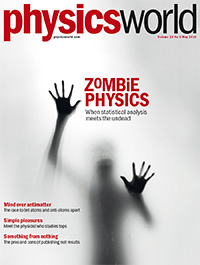 By Matin Durrani
By Matin Durrani
Physics stretches from the small to the large, from the simple to the complex and from low energy to high. It spans the entire alphabet too, with this month’s issue of Physics World including everything from the race to produce anti-atoms (A) at the CERN particle-physics lab near Geneva to a study of the physics of zombies (Z).
Zombies don’t exist, obviously. But we look at two physicists – Alex Alemi and Matt Bierbaum – who have studied the statistical physics of how zombies spread. As science writer Stephen Ornes explains, their interest emerged from a fun student project, but has led to a paper in a leading peer-reviewed journal and helped generate a wider appreciation of statistical physics.
If you’re a member of the Institute of Physics (IOP), you can now enjoy immediate access to the new issue with the digital edition of the magazine in your web browser or on any iOS or Android mobile device (just download the Physics World app from the App Store or Google Play). If you’re not yet in the IOP, you can join as an IOPimember for just £15, €20 or $25 a year to get full access to Physics World digital.
View all posts by this author | View this author's profile
What can cosmic rays tell us about dark matter?
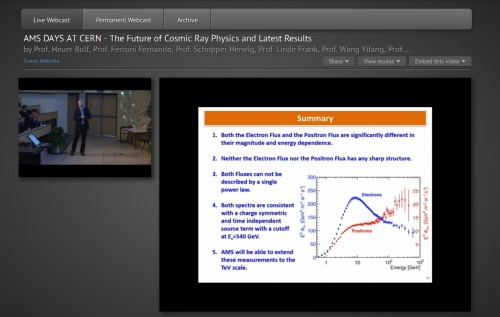
Alive and well: the positron excess as seen by the AMS. (Courtesy: CERN)
By Hamish Johnston
Cosmic rays, dark matter and other astrophysical mysteries are being debated with much vigour at a three-day conference that began this morning at CERN in Geneva. Called “AMS Days at CERN”, the meeting will include presentations of the latest results from the Alpha Magnetic Spectrometer (AMS).
Located on the International Space Station, the AMS measures the energy of high-energy charged particles from the cosmos – otherwise known as cosmic rays. These particles are of great interest because they offer us a window into some of the most violent processes in the universe. Some cosmic rays have probably been accelerated during supernova explosions while others could be produced as matter is sucked into the supermassive black holes that lie at the centres of many galaxies.
View all posts by this author | View this author's profile
What’s the latest matter with antimatter?
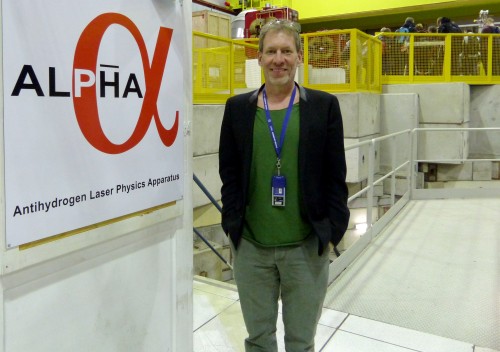
Mind over antimatter: Jeffrey Hangst at the ALPHA experiment at CERN.
By Tushna Commissariat at CERN
While visiting CERN, the world’s biggest particle-physics laboratory, it’s easy to get swept up by the excitement of the Large Hadron Collider and its detectors, especially in the run up to it being switched back on in the coming weeks. But CERN is also host to a variety of other equally exciting experiments that probe some of the biggest unanswered questions in science, such as the experiments that probe the unwieldy world of antimatter. Indeed, CERN’s antimatter programme has received considerable attention in the past, especially thanks to the now-famous book (and later, film) Angels and Demons, where some antimatter was supposedly stolen from the laboratory and used to build a bomb! Suffice to say, antimatter is of interest to physicists and the public alike and so I caught up with physicist Jeffrey Hangst, who is spokesperson of the Antihydrogen Laser Physics Apparatus (ALPHA) experiment, which I also had the chance to visit.
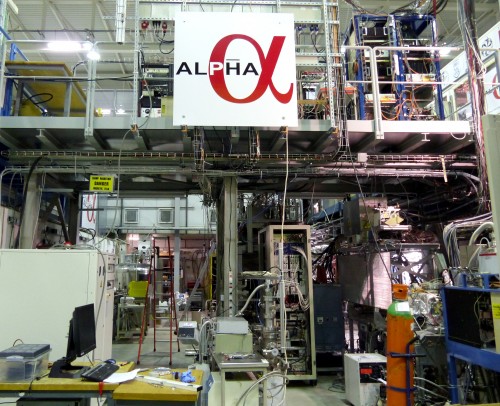
Antimatter factory: a view of the ALPHA 2 set-up.
View all posts by this author | View this author's profile
Quantum landscaping

Artist’s impression of a map of the Quantum Universe (Graphic courtesy of “ILC — form one visual communication”)
By Tushna Commissariat
Here’s a bit of Friday physics fun… I came across this rather interesting image that shows an artist’s impression of a map entitled “The Quantum Universe”. It includes six landmasses all floating in the Big Bang Ocean; including Dark Matter Landmass, Sypersymmetry Reef, Higgs Island and the Land of Ultimate Unification as well as others.
So go ahead and tell us which island you would like to settle down on. Be sure to look carefully at gems like Newton’s Lawn and Mount Einstein before you make your mind up!
To see a larger hi-res image follow this link.
View all posts by this author | View this author's profile
